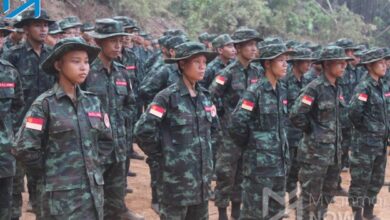
Clashes broke out this week between a coalition of resistance forces and a 100-soldier junta column reportedly sent to guard the office of a Chinese extraction company near the Letpadaung copper mine in Sagaing Region’s Salingyi Township, according to local sources.
Letpadaung local and protest leader Myo Min told Myanmar Now that a convoy of 100 troops left neighbouring Yinmabin Township on May 5 and were seen the following day stationed near the office of Yangtse Copper Co., Ltd.
The company is a subsidiary of Wanbao Mining, which jointly operates the controversial Letpadaung mining site with the Union of Myanmar Economic Holdings Ltd. (UMEHL), a military conglomerate.
On Sunday evening, a four-hour battle took place between the army column and local defence forces, with resistance fighters claiming that they ambushed and surrounded the unit at around 4pm.
“We blocked their path from the front and attacked them from all sides. As far as we know, we had no casualties on our side yesterday,” Ko Khant, a spokesperson for one of the guerrilla groups, said on Monday.
They also reportedly exchanged gunfire for around 10 minutes on Monday morning.
Myanmar Now was unable to confirm whether anyone was killed or captured by either side during the clashes.

Locals around the site of the recent fighting said that they fear for their safety as long as the Myanmar army troops occupy the area.
“Villagers are all scared because [the soldiers] always fire their weapons indiscriminately whenever they enter a village,” a resident said. “Residents of the villages in the area can’t eat or sleep well,” he added.
‘Groundless accusations’
In April, the Yinmabin and Salingyi People’s Defence Forces (PDFs) were among 16 resistance groups active in the townships that jointly condemned the mining projects run by UMEHL and Wanbao as propping up the junta. They called on the companies’ employees to leave their jobs and join the Civil Disobedience Movement (CDM) by May 5.
The Myanmar branches of Wanbao and Yangtse released a joint statement on May 4 claiming that they had been threatened by the PDFs active in the area.
The companies alleged that there were “rumors” and “groundless accusations” regarding their projects and claimed to have halted mining operations after the military coup in February of last year. Any workers seen on site were part of a skeleton crew carrying out “environmental maintenance” only, the company stated.
A worker from Letpadaung’s raw materials processing department who is currently on strike told Myanmar Now that many mine workers had in fact joined the CDM, and that if operations had stopped in Letpadaung, it could be due to the employees’ participation in the movement.
“It’s very likely that the company would have stopped operations, in my opinion. The defence forces could also carry out attacks on them while they are transporting materials,” he said.

A member of the Blood Money Campaign, a grassroots initiative focused on cutting off financial support to the military council, urged Wanbao and its affiliates to withdraw from the country, as further attacks by guerrilla forces could be forthcoming.
“If the Chinese government is going to collaborate with the military that is killing and oppressing the people, it won’t be the people’s fault when [the resistance] starts targeting China’s investments,” the individual said.
‘We are suffering because of these projects’
Wanbao signed a 60-year contract in 2010 with UMEHL and Myanmar’s then government to extract copper from Letpadaung.
Profits from the site are divided between the state-owned No. 1 Mining Enterprise, which takes 51 percent, as well as Wanbao, which receives 30 percent, and UMEHL claiming 19 percent.
Wanbao subsidiary Yangtse now jointly operates the nearby copper mines at Sabetaung and Kyisintaung with UMEHL, known as the S&K mines. Throughout the late 1990s and until 2007, they were operated jointly by the No. 1 Mining Enterprise and Canada’s Ivanhoe Mines, until Canada pulled out of the initiative, according to research published by Amnesty International.
Three years later, Wanbao’s parent company became a joint operator of the S&K mines, as well as Letpadaung, with the three sites comprising what was referred to as the Monywa copper mining project, named for the district in which they are located.
At the time of reporting, Yangtse was taking home 49 percent of the production profits at the S&K mines, with UMEHL claiming the remaining majority.
An October 2021 report by the transparency campaign Publish What You Pay stated that during the 2020-2021 financial year, the Myanmar military could have acquired US$417m from the Letpadaung project and $187m from the projects at Sabetaung and Kyisintaung.
The US government hit Wanbao and its subsidiaries with sanctions in July last year over their operations in Myanmar with the military. In March 2021, both the US and the UK sanctioned UMEHL for serving as a financial arm of the junta.
Locals have long opposed the Letpadaung copper mine, which has caused widespread damage to the surrounding environment and involved the seizure of thousands of acres of land from villagers who were reportedly evicted without sufficient compensation.
“We are suffering because of these projects,” Letpadaung protest leader Myo Min said. “The plants are dying and acid eats away at the houses and the roofs. The locals have eye problems because of the air pollution,” he added, referring to the effects of the mining process.
Letpadaung was the site of a brutal crackdown on local protests against the mine in November 2012, when police were accused of using white phosphorus against the demonstrators. More than 100 people suffered injuries, including those causing disability, as a result of the violence.
Khin Yi Yi Zaw contributed to this report.


![Resistance fighters holding heavy weapons ammunition in central Myanmar. (Photo: Freedom Revolution Force [FRF])](https://myanmar-now.org/en/wp-content/uploads/sites/5/2024/04/438869056_443267851680128_1706386881626943924_n-390x220.jpeg)
